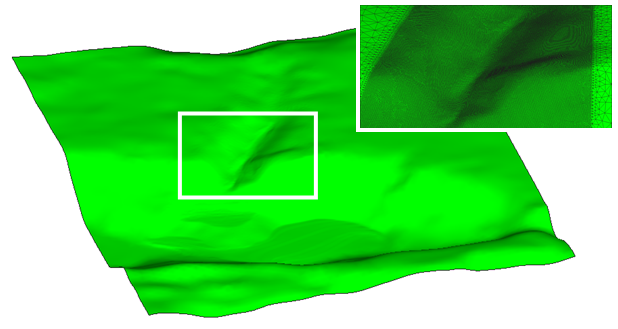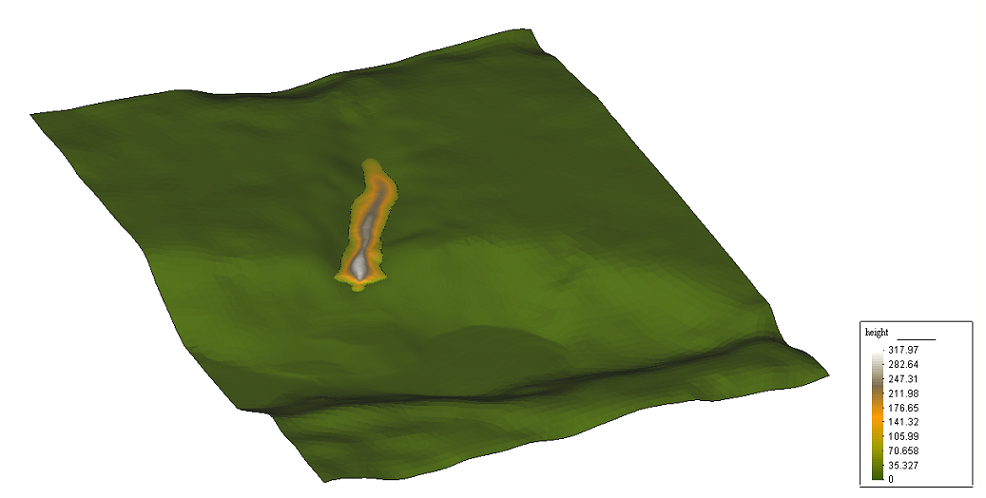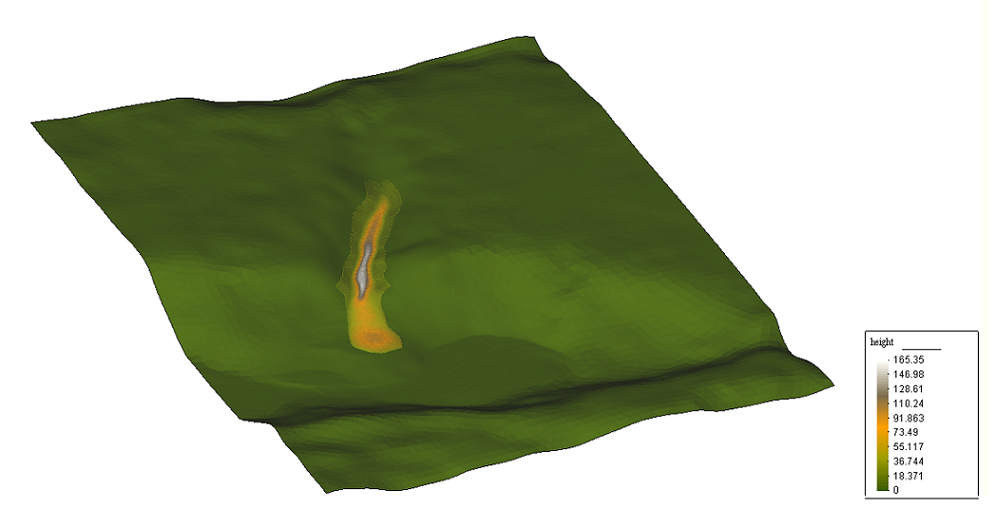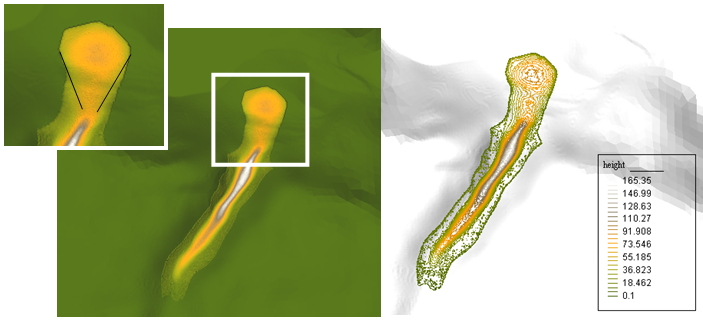Alluvial fan at Coprates Catena in Valles Marineris, Mars: new modeling insights.
- 1Centro de Astrobiología (CSIC-INTA), Torrejón, Madrid, Spain
- 2Universidad Rey Juan Carlos, Móstoles, Madrid, Spain
- 3Universidad de Alcalá de Henares, Alcalá de Henares,Madrid, Spain
1. INTRODUCTION
The purpose of this work is to analyze the formation process of a steep fan-shaped deposit in the Coprates Catena region, using a depth-integrated model. The origin of this fan is however uncertain. Probably a clay-water mixture flowed along a long valley and entered a deep trough giving rise to a stepped fan. According to local morphotectonics [3,7] groundwater-related processes could have been active from Hesperian to early Amazonian, thus implying favorable environmental conditions for the mudflow occurrence during that period.
These types of phenomena are very sensitive to topography, geological and environmental conditions. In absence of erosion and other weathering factors, and once the deposits are formed, they may remain unaltered during millions of years. Therefore, the analysis of these depositional processes may assist us in better understanding the geological and climatological history of Mars.
2. METHODOLOGY
The regional morphology at Coprates Catena has been widely studied and it is geologically well characterized, thus allowing the topographic reconstruction of the area. Some previous works [1,3,8] suggested that the stepped fan-like-structure formation was probably carried out in several phases, with a time-lapse in between. Our study focuses on the last phase of this discontinuous event, when the upper part of the fan was deposited.
The methodology proposed herein consists of: (i) Reconstruction of the channel-fan formation by means of an iterative process using both mapping and mechanical modeling [4], and (ii) back-analysis of the alluvial fan depositional process using a numerical model.
In order to carry out the numerical study of the aforementioned depositional process, the authors propose the use of the depth-integrated model described in [5] based on the depth-integrated Navier-Stokes equations, also known in some disciplines as the Shallow Water Equations. These equations are integrated in space using the Finite Element Method [9] and in time using the two-steps Taylor-Galerkin algorithm [2,6]. The resulting model allows the dynamic simulation of landslides and flowslides, such as granular flows, debris flows or mudflows, providing the arrival time and run-out of the flow, as well as its final depositional volume and shape. The model includes some constitutive models, such as newtonian fluids (laminar and turbulent), Bingham fluids and frictional fluids as well as different bottom-friction laws.
The proposed model requires the following information as input:
(a) Reconstructed topography:
Before running the numerical model over real surficial data, it is necessary to reconstruct the shape of the terrain to a previous state, before the alluvial fan was formed. In order to do that, an iterative process is proposed [4]. Running the model [5] on an initial reshaped surface (with the channel filling volume as the starting condition), new information is obtained to enhance the reconstruction, thus starting an iterative process: alternation between reshaping the topography and running the model is performed until the result of the latter fits the shape and characteristics found in the initial unaltered topography, before the depositional fan-like structure was formed. This reconstructed topography is then interpolated in a non-structured computational mesh of 206702 linear triangles and 103487 nodes (Figure 1).

Figure 1: Reconstructed topography and detailed view of the computational mesh
(b) Mobilized mass:
After topographic reconstruction, the mobilized mass of material must be determined. In order to do that, and, based on what can be identified in the imagery, the channel is filled by the fan-equivalent volume up to a knickpoint (Figure 2).

Figure 2: Mobilized mass (initial condition for t = 0 s)
(c) Type of material:
The type of material involved in the process is given by the parameters of the considered rheological law. These parameters must be determined using a back-analysis technique and thus comparing the final deposited volume, shape, slope and flooding area with the observational data.
3. RESULTS
In the present study a set of simulations have been accomplished using different rheological laws (newtonian, frictional and Bingham fluids) getting the most suitable result according to the current observations of the area for a Bingham fluid of density 1747 kg/m3, viscosity 0.118 Pa s and yield stress of 3 MPa. This result is compatible with a mudflow, probably a clay-water mixture of kaolinite type with a water content of about 53%. The final depositional material is shown in Figures 3 and 4.

Figure 3: Final state of the sliding mass ( t = 21500 s = 5.97 hours)

Figure 4: Plan view and detailed fan-like structure
4. CONCLUSIONS
We have proposed and applied a methodology for the reconstruction of a depositional process in ancient Mars to the particular case of an alluvial fan at Coprates Catena in Valles Marineris. Geomorphological reconstruction of the area of study has been accurately accomplished so that the initial conditions for the triggering event have been determined. A depth-integrated model using the Finite Element Method has been used in order to carry out a back-analysis of the event. The obtained results are in agreement with the observational data and are consistent with the geological characterization of the surrounding area. Therefore, numerical modeling of these processes is proposed as a powerful tool providing a better understanding of the geological and environmental conditions of ancient Mars.
ACKNOWLEDGEMENTS
A.M. is funded by the Project "MarsFirstWater", European Research Council Consolidator Grant no. 818602. T.M. was founded by the grant JAEIntro-2020-CAB-03. The authors thank the Agencia Estatal de Investigación (AEI) project no. MDM-2017-0737.
REFERENCES
[1] Di Achille et al. (2006). Geophysical research letters, 33(7).
[2] Donea (1984). Inter. J. Numer. Methods Eng. 20(1): 101-119.
[3] Grindrod et al. (2018). Icarus, 307, 260-280.
[4] Molina, Herreros, Martínez-Pérez et al. (2021). EPSC2021-129.
[5] Pastor, Herreros et al. (2009). Engineering Geology, 109(1–2): 124-134.
[6] Peraire et al. (1986). Inter. J. Numer. Methods Eng., 22: 547–574.
[7] Salese et al. (2019). Journal of Geophysical Research: Planets, 124(2), 374-395.
[8] Weitz et al. (2006). Icarus, 184(2), 436-451.
[9] Zienkiewicz et al. (2005). The Finite Element Method. Vol. 1-3. 6th Ed. Butterworth-Heinemann.
How to cite: Herreros, I., Molina, A., Martínez-Pérez, T., Bacallado, A., Mata, S., and Gómez, B.: Alluvial fan at Coprates Catena in Valles Marineris, Mars: new modeling insights., European Planetary Science Congress 2021, online, 13–24 Sep 2021, EPSC2021-116, https://doi.org/10.5194/epsc2021-116, 2021.

